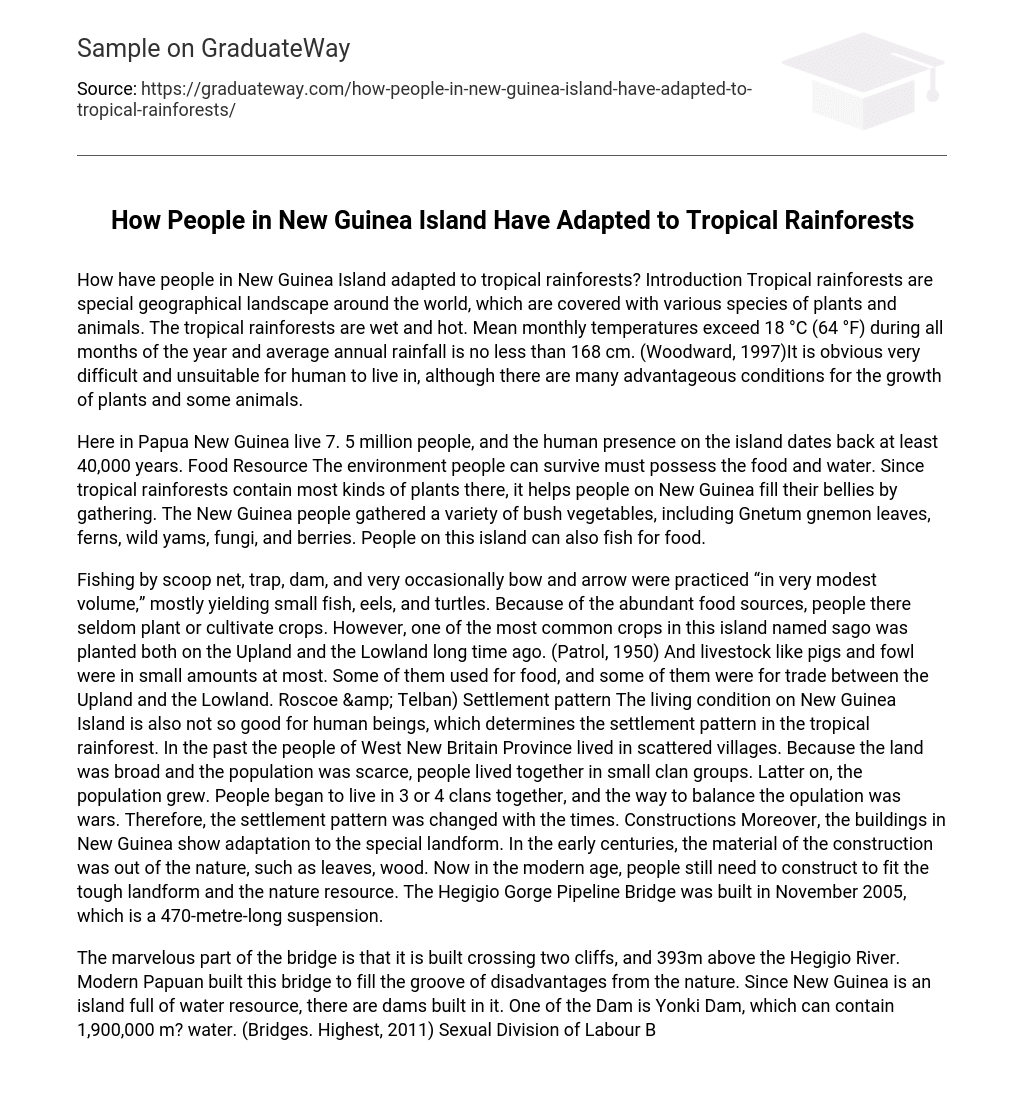How have people in New Guinea Island adapted to tropical rainforests? Introduction Tropical rainforests are special geographical landscape around the world, which are covered with various species of plants and animals. The tropical rainforests are wet and hot. Mean monthly temperatures exceed 18 °C (64 °F) during all months of the year and average annual rainfall is no less than 168 cm. (Woodward, 1997)It is obvious very difficult and unsuitable for human to live in, although there are many advantageous conditions for the growth of plants and some animals.
Here in Papua New Guinea live 7. 5 million people, and the human presence on the island dates back at least 40,000 years. Food Resource The environment people can survive must possess the food and water. Since tropical rainforests contain most kinds of plants there, it helps people on New Guinea fill their bellies by gathering. The New Guinea people gathered a variety of bush vegetables, including Gnetum gnemon leaves, ferns, wild yams, fungi, and berries. People on this island can also fish for food.
Fishing by scoop net, trap, dam, and very occasionally bow and arrow were practiced “in very modest volume,” mostly yielding small fish, eels, and turtles. Because of the abundant food sources, people there seldom plant or cultivate crops. However, one of the most common crops in this island named sago was planted both on the Upland and the Lowland long time ago. (Patrol, 1950) And livestock like pigs and fowl were in small amounts at most. Some of them used for food, and some of them were for trade between the Upland and the Lowland. Roscoe & Telban) Settlement pattern The living condition on New Guinea Island is also not so good for human beings, which determines the settlement pattern in the tropical rainforest. In the past the people of West New Britain Province lived in scattered villages. Because the land was broad and the population was scarce, people lived together in small clan groups. Latter on, the population grew. People began to live in 3 or 4 clans together, and the way to balance the opulation was wars. Therefore, the settlement pattern was changed with the times. Constructions Moreover, the buildings in New Guinea show adaptation to the special landform. In the early centuries, the material of the construction was out of the nature, such as leaves, wood. Now in the modern age, people still need to construct to fit the tough landform and the nature resource. The Hegigio Gorge Pipeline Bridge was built in November 2005, which is a 470-metre-long suspension.
The marvelous part of the bridge is that it is built crossing two cliffs, and 393m above the Hegigio River. Modern Papuan built this bridge to fill the groove of disadvantages from the nature. Since New Guinea is an island full of water resource, there are dams built in it. One of the Dam is Yonki Dam, which can contain 1,900,000 m? water. (Bridges. Highest, 2011) Sexual Division of Labour Because of the different physiological functions inside the males and females, people separately work in the tropical rainforest.
Combined with the special characteristics of New Guinea area, women’s work involved washing sago flour, trap fishing, collecting firewood, making salt, cooking, sewing sago leaves into thatch, and cleaning around the house. Men’s tasks included warfare, felling and pounding the sago palm, hunting, catching fish by damming waterways and making houses and canoes. (Roscoe & Telban)So the most labour work in New Guinea carried out around the main crops Sago. Summary Tropical rainforests are the value of the whole world. With its ecology affects, we can enjoy a more beautiful life on Earth.
Human beings interact with nature to seek a balance. So do the people in the tropical rainforest of New Guinea Island, they have adapted to the tropical rainforest, its climate, its landform, its resources. Reference Bridges. Highest. (2011). Hegigio Gorge Pipeline Bridge. (www. higestbridges. com) PatrolAngoram. (1950). ANG Report No. 11. Port Moresby. RoscoePaul, & TelbanBorut. The People of the Lower Arafundi: Tropical Foragers of the New Guinea Rainforest. WoodwardSusan. (1997). Tropical broadleaf Evergreen Forest: The rainforest. Radford, Virginia, USA: Radford University.





